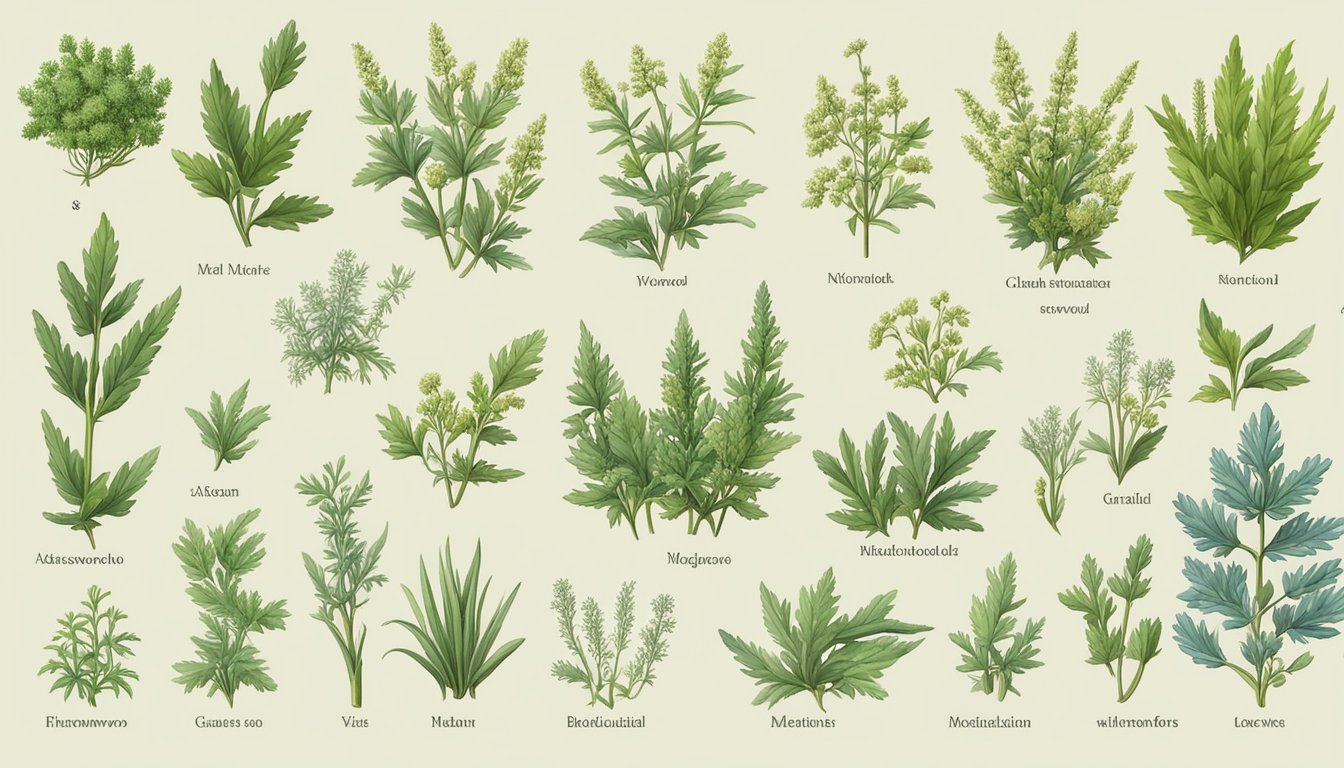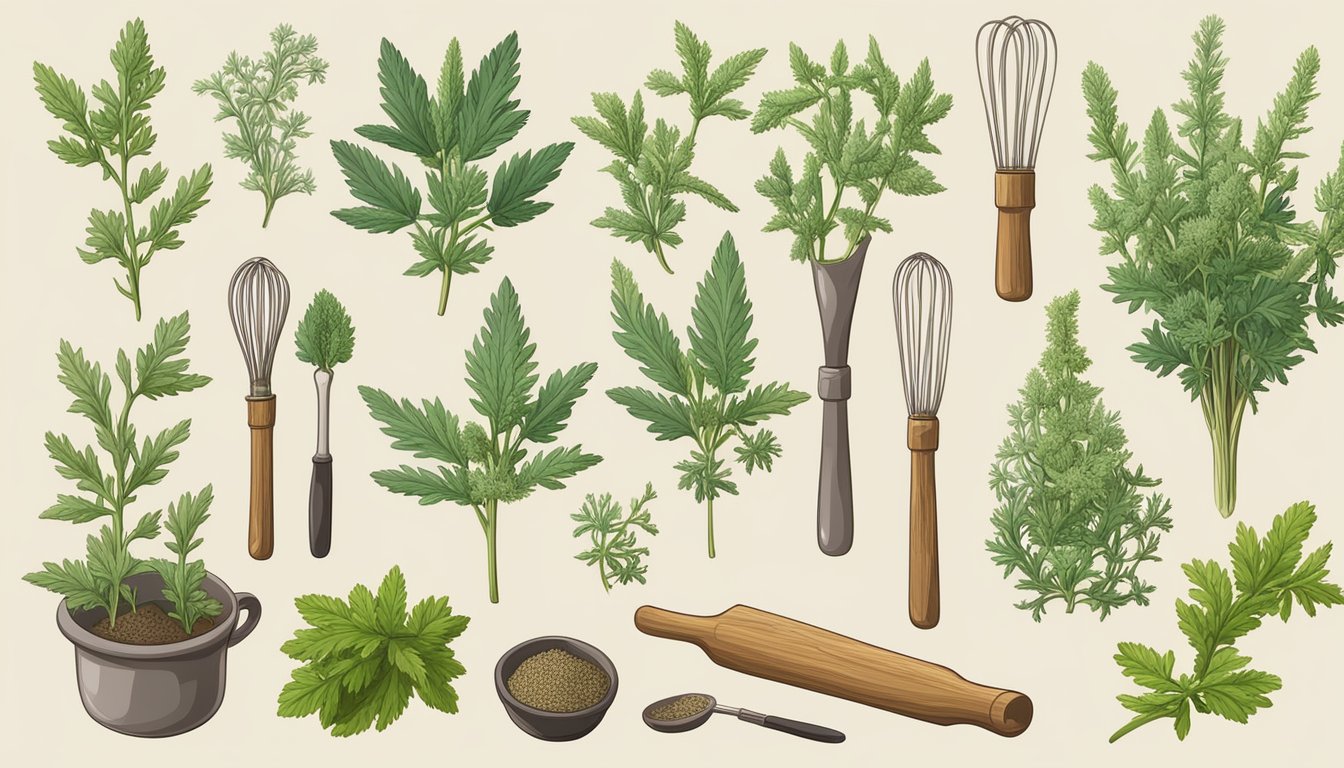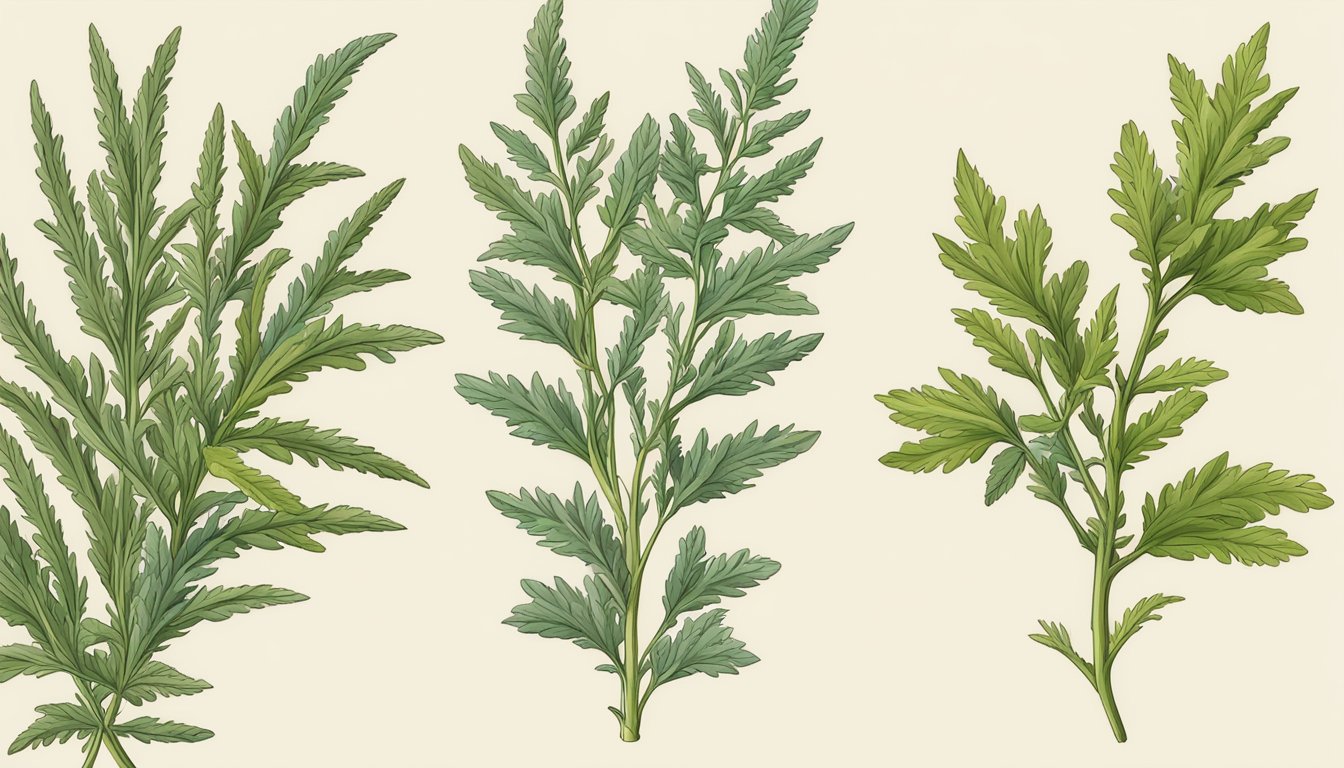TheHerbProf.com is a treasure trove of knowledge for those interested in natural healing and herbal remedies. The website is run by Paul Johnston MD. A naturopathic who has not only received extensive education in the field but also has personal experience in self-healing.
As an herbalist, I often get asked about the differences between mugwort vs wormwood. Both plants belong to the Artemisia genus and share many similarities, but they also have distinct properties and uses. In this article, I will explore the unique characteristics of each herb and clarify any confusion between the two.
Mugwort (Artemisia vulgaris) is a perennial plant that is native to Europe and Asia, but can now be found worldwide. It has been used for centuries in traditional medicine and is known for its calming and relaxing properties. Mugwort is also used in culinary arts, especially in Asian cuisine, as a flavoring agent. On the other hand, wormwood (Artemisia absinthium) is a bitter herb that is primarily used for its medicinal properties. It is a key ingredient in the production of absinthe, a highly alcoholic beverage that was popular in the 19th century. Wormwood is also used to treat digestive issues and is believed to have anti-inflammatory and antiseptic properties.
Despite their similarities, mugwort and wormwood have some key differences. For example, mugwort produces yellow, white, or red flowers, while wormwood produces yellow flowers. Mugwort is also used in a limited culinary capacity, while wormwood is primarily used for medicinal purposes. Understanding the differences between these two plants is important for anyone interested in herbal medicine or culinary arts, and I will delve into these differences in more detail in the following sections.
What Is the Difference Between Mugwort and Wormwood?
Comparison of Classification, Description, Uses, and Origin
As a botanist, I can confidently say that Mugwort and Wormwood are two distinct species belonging to the same genus Artemisia. Mugwort is scientifically known as Artemisia vulgaris, while Wormwood is known as Artemisia absinthium. Although they share some similarities, they have several differences, which I will discuss in this section.
Classification
Mugwort and Wormwood belong to the same botanical family, the daisy family (Asteraceae). They are both perennial herbs with a similar green shade. However, they differ in their classification, with Mugwort being classified as a species of the genus Artemisia, while Wormwood is a distinct species of the same genus.
Description
Mugwort and Wormwood differ in their physical appearance. Mugwort is a tall plant that can grow up to six feet tall, while Wormwood is a smaller plant that grows up to three feet tall. Wormwood leaves are green on both sides, while Mugwort has leaves that are green on the top and white on the bottom. Mugwort plants may have flowers in white, yellow, or red, while Wormwood produces yellow flowers.
Uses
Mugwort and Wormwood have different uses. Mugwort has been used in traditional medicine for centuries and is believed to have a variety of health benefits. It is used to treat digestive problems, menstrual cramps, and anxiety. Mugwort is also used in a limited culinary capacity, mainly as a flavoring agent in some dishes.
Wormwood, on the other hand, is mostly known for its use in the production of absinthe, a highly alcoholic beverage. It is also used in the production of vermouth and as a tonic. Wormwood is an intensely bitter herb and is not recommended for consumption in large quantities.
Origin
Mugwort and Wormwood are native to Europe, Asia, and northern Africa. Mugwort is said to have originated in Europe and Asia, while Wormwood is native to Europe and parts of Asia. Both plants have been introduced to North America and are now found in many parts of the continent.
Mugwort and Wormwood are two distinct species of the same genus Artemisia. They may share some similarities, but they differ in their classification, physical appearance, uses, and origin.
Medicinal Uses of Mugwort and Wormwood

As a traditional medicinal herb, both Mugwort and Wormwood have been used for centuries to treat various ailments. They belong to the same family, Asteraceae, but are different species of the genus Artemisia.
Effects on Epilepsy and Other Health Benefits
Mugwort is believed to have anti-inflammatory and hepatoprotective properties, which can help protect the liver from damage caused by toxins. In traditional Chinese medicine, it is used as moxa, which involves burning dried mugwort to stimulate acupuncture points. Mugwort is also believed to help with lucid dreaming and has been used for this purpose in many cultures.
Wormwood, on the other hand, has been used to treat various diseases, including epilepsy. It contains a compound called thujone, which is believed to be responsible for its medicinal properties. Thujone is known to have an effect on the central nervous system and has been used as a treatment for epilepsy in the past.
While both Mugwort and Wormwood have medicinal properties, it is important to note that they can also have side effects if not used properly. Thujone, for instance, can be toxic if consumed in large amounts. It is, therefore, important to consult a healthcare professional before using either herb medicinally.
Mugwort and Wormwood have been used for centuries as traditional medicinal herbs to treat various ailments. While they have been found to have medicinal properties, it is important to use them with caution and under the guidance of a healthcare professional.
Culinary and Other Uses of Mugwort Vs Wormwood

Differences in Culinary Uses and Other Uses – Mugwort Vs Wormwood
Mugwort and wormwood are two plants that are often confused with each other, but they have distinct differences in their culinary uses and other uses.
Mugwort is a versatile culinary herb that is used in many different cuisines around the world. In Japanese cuisine, mugwort leaves are used to make mochi, a type of rice cake. Mugwort is also used to flavor soups, stews, and teas. The essential oil of mugwort is used in perfumes and aromatherapy.
On the other hand, wormwood is primarily known for its use in absinthe production. It is the key ingredient that gives absinthe its distinctive bitter flavor and green color. Wormwood is also used in protective spells and rituals, and is believed to have appetite-boosting properties.
When it comes to their other uses, mugwort and wormwood have some similarities. Both plants are believed to have medicinal properties and are used to treat a variety of ailments. Mugwort is used to treat digestive issues, menstrual cramps, and fever. Wormwood is also used to treat digestive issues, as well as fever and malaria.
In terms of appearance, mugwort and wormwood are similar. They both have long, narrow leaves and can grow up to six feet tall. However, wormwood is typically shorter than mugwort, reaching a height of only five feet.
While mugwort and wormwood may look similar, they have distinct differences in their culinary uses and other uses. Mugwort is a versatile culinary herb that is used in many different cuisines around the world, while wormwood is primarily known for its use in absinthe production. Both plants have medicinal properties and are used to treat a variety of ailments.
Potential Confusion and Importance of Proper Identification – Mugwort Vs Wormwood

As both Mugwort and Wormwood belong to the same genus, Artemisia, they share many similarities in appearance, which can lead to confusion between the two plants. Misidentification can have serious consequences, as both plants contain toxic compounds that can cause health problems if ingested. Therefore, it is important to properly identify these plants before using them for any purpose.
Similarities in Appearance and Potential Risks of Misidentification
Mugwort and Wormwood are both perennial herbs that can grow up to six feet tall and have silvery-green leaves with a bitter taste. They also have similar-looking flowers that bloom in late summer and early fall. However, there are some key differences between the two plants that can help with identification.
Mugwort leaves are green on the top and white underneath, while Wormwood leaves have a silvery top and bottom. Mugwort leaves also have pointed tips and purplish stems, while Wormwood leaves are more finely divided and have a gray-green color. Another way to tell the difference between the two plants is by their flowers. Mugwort has small, reddish-brown flowers that grow in clusters, while Wormwood has yellow-green flowers that grow in small, ball-shaped clusters.
Misidentification can lead to serious consequences, as both Mugwort and Wormwood contain toxic compounds that can cause health problems if ingested. Mugwort contains thujone, which can cause seizures and other neurological problems if consumed in large amounts. Wormwood contains absinthin and thujone, which can cause hallucinations, seizures, and even death if consumed in large amounts.
It is important to properly identify Mugwort and Wormwood before using them for any purpose. Misidentification can lead to serious health problems and even death. If you are unsure about the identity of a plant, it is best to consult a professional or avoid using it altogether.
Before You Go – Mugwort Vs Wormwood

While mugwort and wormwood are often confused for one another, they are, in fact, two separate species of plants within the same genus, Artemisia. Mugwort, scientifically known as Artemisia vulgaris, is a perennial herb that is native to Europe, Asia, and northern Africa. On the other hand, wormwood, scientifically known as Artemisia absinthium, is a shrub that is native to temperate regions of Eurasia and Northern Africa.
One of the main differences between mugwort and wormwood is their usage. Mugwort has been used in traditional medicine for centuries and is believed to have a variety of health benefits. It is also used in cooking, particularly in Asian cuisine. On the other hand, wormwood is most commonly known for its use in absinthe, a highly alcoholic drink that was banned in many countries due to its hallucinogenic properties.
Another difference between the two plants is in their appearance. Mugwort is taller and more slender than wormwood and is distinguished by being scentless, with its leaves being green above and white below. Wormwood, on the other hand, has a distinctive bitter taste and a strong aroma.
Despite their differences, both mugwort and wormwood have been used in traditional medicine for centuries and are believed to have various health benefits. They are also both members of the daisy family and the same genus, Artemisia.
Overall, it is important to understand the differences between mugwort and wormwood, as well as their similarities, in order to properly identify and use them in cooking and traditional medicine.
Mugwort Vs Wormwood: A Connection with TheHerbProf.com
Mugwort and Wormwood, two intriguing herbs in the world of natural remedies! Now, let’s see how they link to TheHerbProf.com.
Mugwort is a herb that’s all about the power of dreams. It’s like a dream weaver, enhancing your nighttime adventures. Now, mix this with the herbal wisdom of TheHerbProf.com, and you’ve got a dreamy duo!
Wormwood, on the other hand, is the star of the show in absinthe. It’s like the mysterious stranger, adding a touch of intrigue to your drink. When you pair this with the insights from TheHerbProf.com, it’s like having a herbalist bartender in your pocket!
For example, love the dream-enhancing effects of Mugwort? Hop over to TheHerbProf.com to learn more about its mystical properties. It’s like a dream journey, and you’re the explorer!
Or maybe you’re fascinated by the unique flavor of Wormwood in absinthe? Swing by TheHerbProf.com to discover its intriguing uses. It’s like a journey into the heart of herbal mystery, and you’re the adventurer!
References – Mugwort Vs Wormwood
Little Herb Encyclopedia, by Jack Ritchason; N.D., Woodland Publishing Incorporated, 1995
The Ultimate Healing System, Course Manual, Copyright 1985, Don Lepore
Planetary Herbology, Michael Tierra, C.A., N.D., Lotus Press, 1988
Handbook of Medicinal Herbs, by James A. Duke, Pub. CRP Second Edition 2007
The Complete Medicinal Herbal, by Penelope Ody, Published by Dorling Kindersley
Check the Following Articles!
Catmint Vs Catnip: What’s the Difference?
Chamomile Vs Daisy: A Comparison of Two Popular Flowers
Tulsi Vs Basil: Differences and Similarities
Frequently Asked Questions – Mugwort Vs Wormwood

What are the distinguishing characteristics between mugwort and wormwood?
Mugwort and wormwood are two closely related plants that share many similarities. They both belong to the Artemisia genus and have silver-grey foliage. However, there are some key differences between the two. Mugwort usually grows larger than wormwood and has uniquely pointed leaves, while wormwood has rounded leaves. Additionally, mugwort has a sweet, herbal aroma, while wormwood has a bitter, medicinal scent.
Can mugwort tea be used for medicinal purposes and if so, what are its benefits?
Mugwort tea has been used for centuries in traditional medicine for a variety of purposes. It is believed to have anti-inflammatory, antifungal, and antibacterial properties, and may also help with digestive issues, anxiety, and irregular periods. However, more research is needed to confirm these benefits, and mugwort should not be used as a substitute for professional medical advice.
Is smoking mugwort safe, and what effects does it have?
Smoking mugwort is not recommended, as it can be harmful to the lungs and may cause respiratory issues. Additionally, the effects of smoking mugwort are not well understood, and it is not recommended as a substitute for professional medical treatment.
How does wormwood interact with the human body, and what are its uses?
Wormwood has been used for centuries in traditional medicine for its antiseptic, antifungal, and antibacterial properties. It is also known for its ability to stimulate the digestive system and increase appetite. However, wormwood should be used with caution, as it contains thujone, a toxic compound that can cause seizures and other adverse effects in high doses.
What are the differences between sweet wormwood and common wormwood?
Sweet wormwood, also known as Artemisia annua, is a different species of wormwood than common wormwood, which is also known as Artemisia absinthium. Sweet wormwood is primarily used in traditional Chinese medicine to treat fever and malaria, while common wormwood is used for digestive issues and as a flavoring agent in absinthe.
Can mugwort be used as a natural remedy for parasites?
There is some evidence to suggest that mugwort may have antiparasitic properties and could be used as a natural remedy for parasites. However, more research is needed to confirm these benefits, and mugwort should not be used as a substitute for professional medical advice.


